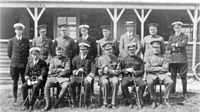Godfrey Paine - Picture
More about World War 1

|
|
Godfrey Paine
Godfrey Marshall Paine
Allegiance: United Kingdom
Service/branch: Royal Navy, Royal Air Force
Years of service: 1885-1920
Rank: Rear Admiral
(Air Vice Marshal before retirement)
Commands held: Central Flying School
Fifth Sea Lord
HMS Actaeon
Battles/wars: World War I
Awards: Knight Commander of the Order of the Bath
Member of the Royal Victorian Order
Distinguished Service Medal (United States)
Rear Admiral Sir Godfrey Marshall Paine KCB MVO (21 November 1871 - 23 March 1932) was a senior commander in the Royal Naval Air Service and the Royal Air Force in the early part of the 20th century. He is possibly the only professional officer to have held flag, general and air officer ranks.
Naval career
Paine joined the Royal Navy as a midshipman in early 1885. He was a lieutenant on HMS Renown, before becoming First Lieutenant on the armoured cruiser HMS Hogue. In 1903 Paine was promoted to commander and later served as the executive officer on his old ship HMS Renown.
In 1907 Paine was promoted captain and in 1909 he was appointed the Officer Commanding the Third Destroyer Flotilla. This appointment was followed by command of the torpedo schoolship HMS Actaeon in 1911. It was while Paine was in command of Actaeon that he first became involved in naval aviation. The first four royal naval and royal marine officers who learnt to fly (Longmore, Samson, Gerrard and Gregory) were borne on the books of Actaeon and Paine took a keen interest in their progress.

Picture - The Central Flying School staff in January 1913. Paine is in the front row, shown third from the left.
In 1912, Paine was appointed as the first commandant of the Central Flying School at RAF Upavon, so, before taking up this post, he learned to fly, being awarded Pilot's Licence No. 217 on 15 May 1912 (at the age of 40). Three years later in 1915, after the Royal Naval Air Service has broken away from the Royal Flying Corps, the Royal Navy established the Central Depot and Training Establishment. The new unit was based at Cranwell and Paine was raised to the rank of Commodore and sent there as its first commander. Just over a year later, in early 1917, Paine was appointed Fifth Sea Lord and Director of Naval Aviation.
RAF and later career
With the establishment of the RAF in 1918, the posts of Fifth Sea Lord and Director of Naval Aviation were abolished and the Navy's aircraft and aviators were transferred to the RAF. Paine was promoted to major-general (a rank of the RAF at that time) and appointed to the Air Council as Master-General of Personnel. With the introduction of RAF-specific ranks in 1919, Paine was regraded to air vice-marshal. His last military appointment was as Inspector-General of the RAF. On his retirement from the RAF in 12 May 1920, Paine reverted to the equivalent naval rank (rear admiral). Excluding those with honorary ranks such as royalty, Paine is possibly the only person to have held flag, general and air officer ranks.
Honours and awards
His awards included:
Knight Commander of the Order of the Bath - 12 Mar 1918 (CB - 1914)
Member of the Royal Victorian Order - 11 Mar 1906
Chevalier of the Order of the Crown (Belgium) - 8 Nov 1918
Order of the Rising Sun, 2nd Class (Japan) - 8 Nov 1918
Distinguished Service Medal (United States) - 16 Dec 1919
More aircraft.
Source: WikiPedia